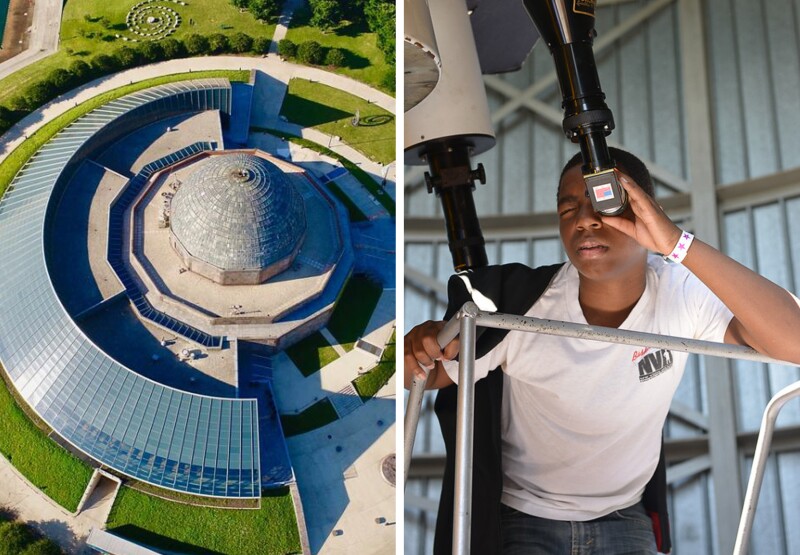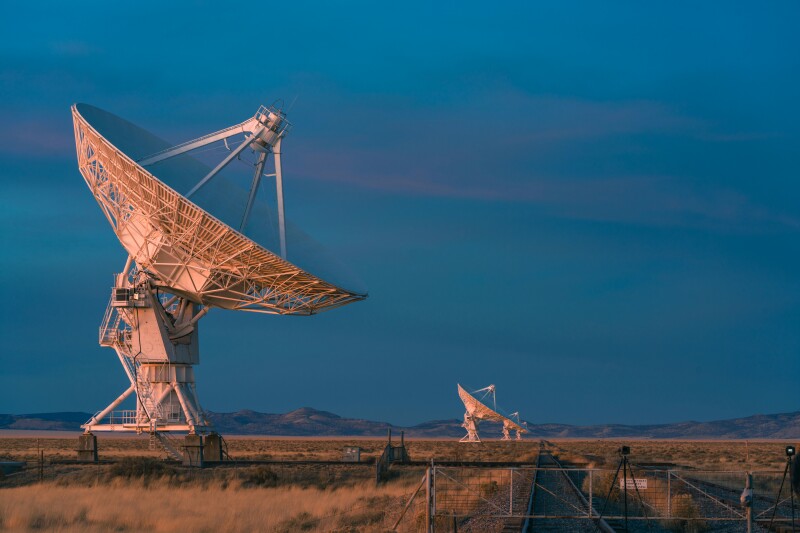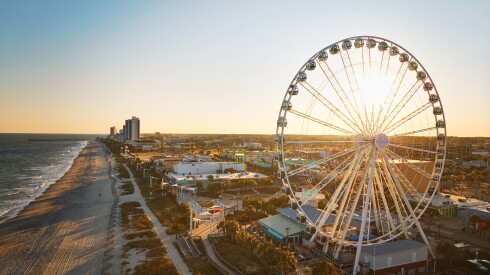There’s no American road more famous than Route 66. Stretching from Chicago to Santa Monica, this legendary highway—celebrating its 100th anniversary in 2026—was once the main artery carrying folks across the country. Although officially decommissioned in 1985, the route remains a popular pilgrimage for road-trippers seeking a healthy dose of nostalgic Americana, from kitschy roadside attractions to midcentury-chic motels to dramatic landscapes across thousands of miles.
But there’s another side to Route 66 that most travelers overlook: the night sky. Thanks to low light pollution in many regions along the route, it’s possible to pair your road trip with some truly spectacular stargazing—and daytime excursions to planetariums, museums, and even impact craters, too. Here’s where to stop along your Route 66 road trip for some astronomy-themed fun.

The Adler at Night program is year-round on Wednesday nights, and includes access to exhibits after hours.
Photos courtesy of Adler Planetarium
Adler Planetarium, Chicago
Route 66 originates in Chicago, where you can set the tone for your cross-country stargazing road trip at the Adler Planetarium. Opened in 1930, four years after Route 66 itself, the Adler was the first planetarium in the Western Hemisphere; today, it’s not only a museum for the public but also an active research facility. Chicago’s lights make it tough to see the stars unaided, but the Adler offers immersive sky shows in its dome theater by day, from a documentary about the hypothetical Planet X to an Afrofuturist animation that tackles the intersection of science and culture to a collaboration with the Joffrey Ballet.
But there are stargazing opportunities here, too. Time your road trip to the Adler at Night program on Wednesday nights year-round, which includes access to exhibits after hours, plus access to the Doane Observatory and the telescope terrace, where the public can view the night sky through a variety of instruments. Adler astronomers and volunteers also host free telescope observing sessions across Chicago.
Where to stay: Hotel EM2, Autograph Collection, is an art-meets-science-themed boutique hotel on Chicago’s Magnificent Mile. It’s about a 15-minute drive—or an hour-long walk through Millennium Park—to the Adler Planetarium.
St. Louis, Missouri
About halfway through Missouri, Route 66 passes through St. Louis, a city with an abundance of stargazing opportunities. Start at the McDonnell Planetarium at the St. Louis Science Center, where you’ll find daily star shows and space exhibits, as well as weekly daytime sun-observing sessions and monthly nighttime Star Parties.
Once you’ve brushed up on your celestial knowledge, you can see how much you’ve learned. About 10 miles west of the city, Stacy Park in Olivette, Missouri, was designated an Urban Night Sky Place in 2021 by DarkSky International, an organization dedicated to preserving the night sky. Open 24 hours a day, it’s the perfect spot to see how many constellations, planets, and other celestial objects you can identify. For guided night sky observations, several local observatories host public viewing events, including the Crow Observatory, part of Washington University in St. Louis.
Where to stay: The Moonrise Hotel, about a 10-minute drive from the McDonnell Planetarium, is a space-themed stay near St. Louis that aligns perfectly with Route 66 kitsch.

These 27 active radio dishes explore black holes, among other things.
Photo by Yifu Wu/Unsplash
NRAO Very Large Array, near Socorro, New Mexico
As Route 66 passes through Albuquerque, sci-fi fans will want to take a detour off the Mother Road for a must-see astronomy site. Drive two hours southwest to visit the National Radio Astronomy Observatory’s Very Large Array (VLA). This sprawling field of 27 active radio dishes might be best known for its starring role in the 1997 film Contact, but it plays a real-life role in exploring black holes, pulsars, and distant galaxies.
While the VLA visitor center and self-guided walking tour are only accessible during the daytime, they offer insight into how scientists “see” the universe using radio waves instead of visible light. Come nighttime, there’s little light pollution in this part of New Mexico, so it’s easy to go stargazing on your own. Plan to spend the night in Magdalena, about 25 miles east of the VLA, or Socorro, a further 25 miles east from Magdalena; you’ll pass through both on the way back to Route 66.
Where to stay: Set just west of Magdalena, the Rancho Magdalena Bed & Breakfast is an appealing place for stargazing after your day at the VLA. If it gets chilly at night, the rooms have kivas, or Pueblo-style fireplaces.
Flagstaff, Arizona
Head back to Route 66 and make your way toward Flagstaff, the world’s first International Dark Sky City, designated by DarkSky International in 2001. The community’s pioneering lighting ordinances, first enacted in the 1950s to support local observatories, make it an ideal locale for stargazers. The original ordinance restricted the use of searchlights, while newer ones cover everything from outdoor lighting brightness to directing light downward, keeping light pollution minimal.
While here, be sure to visit Lowell Observatory, where astronomer Clyde Tombaugh discovered Pluto in 1930. The observatory is home to astronomy galleries, historic facility tours, and nightly telescope viewing opportunities, plus an open-air rooftop planetarium with laser-guided sky shows. And if your visit coincides with a full moon, you can join one of Flagstaff’s free guided full moon hikes, run by the City of Flagstaff Open Space Program.
During the day, take a side trip to Meteor Crater National Landmark, a nearly mile-wide impact site 45 minutes east of Flagstaff. It’s one of the best-preserved meteorite craters in the world.
Where to stay: High Country Motor Lodge sits right on Route 66, but it’s not a dusty relic from a bygone era. A total overhaul in 2022 transformed this ‘60s-era property into one of Flagstaff’s chicest stays.

Joshua Tree alone has four designated stargazing sites.
Photo by Ken Cheung/Unsplash
Joshua Tree National Park, California
When Route 66 reaches Amboy, California, take an hour detour south to Joshua Tree National Park, an International Dark Sky Park. The dry, high desert climate and lack of light pollution make it one of the best stargazing destinations in the country. Joshua Tree has four designated stargazing sites—the parking lots at Quail Springs, Hidden Valley, Cap Rock, and Ryan Mountain—but you can also use roadside pullouts anywhere in the park.
In the gateway town of Twentynine Palms, located at the park’s North Entrance, the Sky’s The Limit Observatory and Nature Center hosts monthly night sky viewing events and the annual Night Sky Festival, a two-day event held in October.
Where to stay: Book a geodesic dome at the Kosmic Tortoise to enjoy stargazing from the comfort of a plush bed. It’s a 15-minute drive to the Sky’s The Limit and the entrance to Joshua Tree National Park.

The Griffith Observatory has several telescopes that allow visitors to peer into space.
(Left) Photo by Alexandr Voronsky/Unsplash (Right) Anastasiya Badun/Unsplash
Griffith Observatory, Los Angeles
As you approach the end of Route 66 in Santa Monica, you might encounter a few Hollywood stars. But forget about them—take a look at real stars at Griffith Observatory, perched high above Los Angeles in Griffith Park.
The Observatory, which has free admission (but paid parking) is open late, until 10 p.m. six nights a week, and visitors can use its many telescopes to gaze into space, not to mention catch shows at the planetarium and theater, view astronomy exhibits, and even get a good view of the Hollywood sign. Don’t miss the free public star parties held monthly, where volunteers from local astronomy organizations set up dozens of telescopes on the lawn for visitors to peer through.
Where to stay: After a long journey, treat yourself to a luxurious night at the art deco Georgian Hotel in Santa Monica, only a 10-minute walk from the Route 66 “End of the Trail” sign on the Santa Monica Pier.











